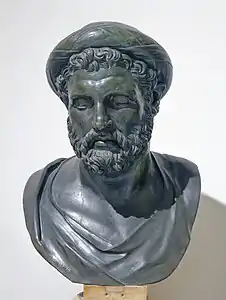Archytas
Archytas (/ˈɑːrkɪtəs/; Greek: Ἀρχύτας; 435/410–360/350 BC[2]) was an Ancient Greek mathematician, music theorist,[3] statesman, and strategist. He was a scientist and philosopher affiliated with the Pythagorean school and famous for being the reputed founder of mathematical mechanics and a friend of Plato.[4]
Archytas | |
|---|---|
 Bust from the Villa of the Papyri in Herculaneum, once identified as Archytas, now thought to be Pythagoras[1] | |
| Born | 435/410 BC |
| Died | 360/350 BC |
| Era | Pre-Socratic philosophy |
| Region | Western philosophy |
| School | Pythagoreanism |
Notable ideas | Doubling the cube |
As a Pythagorean, Archytas believed that arithmetic (logistic), rather than geometry, provided the basis for satisfactory proofs.[5]
Life
Archytas was born in the Greek city of Taras (Tarentum), Magna Graecia, and was the son of either Mnesagoras or Hadees. He presumably was taught by Philolaus, and taught mathematics to Eudoxus of Cnidus and to Eudoxus' student, Menaechmus.
Politically and militarily, Archytas appears to have been the dominant figure in Tarentum in his generation, somewhat comparable to Pericles in Athens a half-century earlier. The Tarentines elected him strategos ("general") seven years in a row, a step that required them to violate their own rule against successive appointments. Archytas was allegedly undefeated as a general in Tarentine campaigns against their southern Italian neighbors.
In his public career, Archytas had a reputation for virtue as well as efficacy. The Seventh Letter, traditionally attributed to Plato, asserts that Archytas attempted to rescue Plato during his difficulties with Dionysius II of Syracuse. Some scholars have argued that Archytas may have served as one model for Plato's philosopher king, and that he influenced Plato's political philosophy as expressed in The Republic and other works.
Works
Archytas named the harmonic mean, important much later in projective geometry and number theory, though he did not discover it.[6] According to Eutocius, Archytas was the first to solve the problem of doubling the cube (the so-called Delian problem) with an ingenious geometric construction.[7][8] Hippocrates of Chios before had reduced this problem to the finding of two mean proportionals. According to Diogenes Laërtius, Archytas' demonstration, which uses lines generated by moving figures to construct the two proportionals between magnitudes, was the first in which geometry was studied with mechanical concepts.[9] The topic of proportions, which Archytas seems to have worked on extensively, is also treated in book VIII of Euclid's Elements, where the construction for two proportional means can be found, equivalent to the extraction of the cube root.
Later tradition regarded Archytas as the founder of mathematical mechanics.[10] Vitruvius includes him in a list of twelve authors who wrote works on mechanics.[11] Thomas Nelson Winter presents evidence that the pseudo-Aristotelian Mechanical Problems might have been authored by Archytas and later misattributed.[12] As described in the writings of Aulus Gellius five centuries after him, Archytas was reputed to have designed and built some kind of bird-shaped, self-propelled flying device known as the pigeon, said to have flown some 200 meters.[13][14]
Notes
- Archita; Pitagora, Sito ufficiale del Museo Archeologico Nazionale di Napoli, retrieved 25 September 2012
- Philippa Lang, Science: Antiquity and its Legacy, Bloomsbury Academic, 2015, p. 154.
- Barbera, André (2001). "Archytas of Tarentum". Grove Music Online. Oxford: Oxford University Press. doi:10.1093/gmo/9781561592630.article.01183. ISBN 978-1-56159-263-0. Retrieved 25 September 2021. (subscription or UK public library membership required)
- Debra Nails, The People of Plato, ISBN 1603844031, p. 44
- Morris Kline, Mathematical Thought from Ancient to Modern Times Oxford University Press, 1972 p. 49
- J. J. O'Connor and E. F. Robertson. Archytas of Tarentum. The MacTutor History of Mathematics archive. Visited 11 August 2011.
- Eutocius, commentary on Archimedes' On the sphere and cylinder.
- "Doubled Cube of Archytus". Archived from the original on 2008-07-18. Retrieved 2015-03-29.
- Plato blamed Archytas for his contamination of geometry with mechanics (Plutarch, Symposiacs, Book VIII, Question 2 Archived 2019-07-28 at the Wayback Machine): And therefore Plato himself dislikes Eudoxus, Archytas, and Menaechmus for endeavoring to bring down the doubling the cube to mechanical operations; for by this means all that was good in geometry would be lost and corrupted, it falling back again to sensible things, and not rising upward and considering immaterial and immortal images, in which God being versed is always God.
- Laërtius 1925, § 83: Vitae philosophorum
- Vitruvius, De architectura, vii.14.
- Thomas Nelson Winter, "The Mechanical Problems in the Corpus of Aristotle," DigitalCommons@University of Nebraska - Lincoln, 2007.
- Aulus Gellius, "Attic Nights", Book X, 12.9 at LacusCurtius
- ARCHYTAS OF TARENTUM, Technology Museum of Thessaloniki, Macedonia, Greece. Archived December 26, 2008, at the Wayback Machine
References
 Laërtius, Diogenes (1925). . Lives of the Eminent Philosophers. Vol. 2:8. Translated by Hicks, Robert Drew (Two volume ed.). Loeb Classical Library.
Laërtius, Diogenes (1925). . Lives of the Eminent Philosophers. Vol. 2:8. Translated by Hicks, Robert Drew (Two volume ed.). Loeb Classical Library.
Further reading
- von Fritz, Kurt (1970). "Archytas of Tarentum". Dictionary of Scientific Biography. Vol. 1. New York: Charles Scribner's Sons. pp. 231–233. ISBN 0-684-10114-9. on line
- Huffman, Carl A. Archytas of Tarentum, Cambridge University Press, 2005, ISBN 0-521-83746-4
External links
- Huffman, Carl. "Archytas". In Zalta, Edward N. (ed.). Stanford Encyclopedia of Philosophy.
- O'Connor, John J.; Robertson, Edmund F., "Archytas", MacTutor History of Mathematics Archive, University of St Andrews
- Pseudo-Aristotle, Mechanica – Greek text and English translation
- Complete fragments (Greek–Spanish bilingual edition)
- Fragments and Life of Archytas